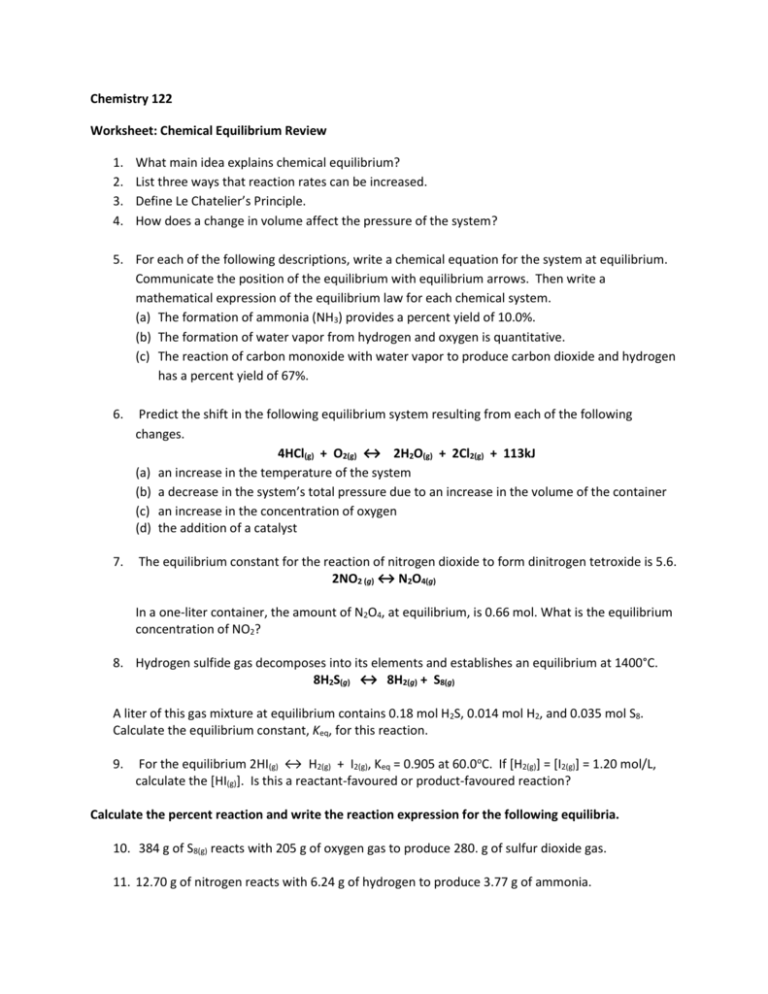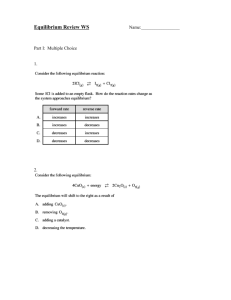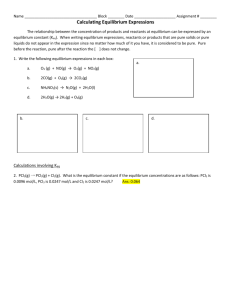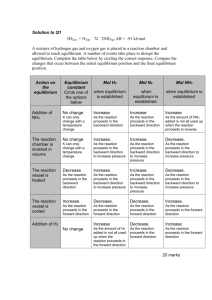kb_-_chem_eqm_review
advertisement

Chemistry 122 Worksheet: Chemical Equilibrium Review 1. 2. 3. 4. What main idea explains chemical equilibrium? List three ways that reaction rates can be increased. Define Le Chatelier’s Principle. How does a change in volume affect the pressure of the system? 5. For each of the following descriptions, write a chemical equation for the system at equilibrium. Communicate the position of the equilibrium with equilibrium arrows. Then write a mathematical expression of the equilibrium law for each chemical system. (a) The formation of ammonia (NH3) provides a percent yield of 10.0%. (b) The formation of water vapor from hydrogen and oxygen is quantitative. (c) The reaction of carbon monoxide with water vapor to produce carbon dioxide and hydrogen has a percent yield of 67%. 6. Predict the shift in the following equilibrium system resulting from each of the following changes. 4HCl(g) + O2(g) ↔ 2H2O(g) + 2Cl2(g) + 113kJ (a) an increase in the temperature of the system (b) a decrease in the system’s total pressure due to an increase in the volume of the container (c) an increase in the concentration of oxygen (d) the addition of a catalyst 7. The equilibrium constant for the reaction of nitrogen dioxide to form dinitrogen tetroxide is 5.6. 2NO2 (g) ↔ N2O4(g) In a one-liter container, the amount of N2O4, at equilibrium, is 0.66 mol. What is the equilibrium concentration of NO2? 8. Hydrogen sulfide gas decomposes into its elements and establishes an equilibrium at 1400°C. 8H2S(g) ↔ 8H2(g) + S8(g) A liter of this gas mixture at equilibrium contains 0.18 mol H2S, 0.014 mol H2, and 0.035 mol S8. Calculate the equilibrium constant, Keq, for this reaction. 9. For the equilibrium 2HI(g) ↔ H2(g) + I2(g), Keq = 0.905 at 60.0oC. If [H2(g)] = [I2(g)] = 1.20 mol/L, calculate the [HI(g)]. Is this a reactant-favoured or product-favoured reaction? Calculate the percent reaction and write the reaction expression for the following equilibria. 10. 384 g of S8(g) reacts with 205 g of oxygen gas to produce 280. g of sulfur dioxide gas. 11. 12.70 g of nitrogen reacts with 6.24 g of hydrogen to produce 3.77 g of ammonia.









